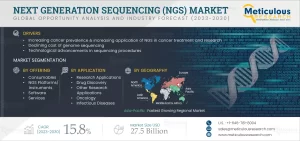The Next Generation Sequencing (NGS) Market is expected to reach $27.5 billion by 2030, at a CAGR of 15.8% from 2023–2030.
Sequencing is a pivotal process that involves determining the precise nucleic acid sequence in DNA or RNA samples. This fundamental technique has undergone significant evolution, particularly with the introduction of Next Generation Sequencing (NGS). NGS has accelerated the pace of biological and medical research, enabling scientists to collect vast amounts of DNA sequence data quickly and cost-effectively. The advancements in genomics research have played a crucial role in dramatically reducing the costs associated with genome sequencing, making it more accessible to researchers and clinicians alike.
According to the National Human Genome Research Institute (NHGRI), the cost of sequencing a human genome has plummeted from an astonishing USD 29,092 in 2010 to a mere USD 562 in 2021. This dramatic reduction underscores the technological advancements in NGS and its implications for healthcare and research.
Download Sample Report Here – https://www.meticulousresearch.com/download-sample-report/cp_id=5040

The Impact of Genomics Research
The field of genomics relies heavily on sequencing to assemble genomes, explore the genetic foundations of human diseases, and delve into various medical domains such as reproductive medicine, oncology, and infectious diseases. The advent of low-cost genome sequencing is poised to revolutionize healthcare delivery. This transformation enables healthcare professionals to recommend biomarker testing more frequently and explore the viability of targeted therapies and personalized medicine for patients. Consequently, this enhances the pace of clinical research in areas like cancer and other genetically linked diseases.
The first successful sequencing of the human genome in 2003 cost an astonishing USD 2.7 billion. By 2013, the cost had decreased to a few thousand dollars, showcasing the rapid advancements in sequencing technologies. As of 2021, the cost of genome sequencing had further declined to approximately USD 450–850. With the increasing demand for sequencing services, it is anticipated that providers will continue to lower prices, driven by advancements in sequencing technologies and processes.
Key Developments in NGS Technology
In September 2022, Illumina, Inc. (U.S.) unveiled a groundbreaking line of DNA sequencing machines capable of sequencing the human genome for an unprecedented cost of just USD 200. This significant reduction in cost illustrates the ongoing efforts by market players to innovate and introduce advanced NGS products that enhance efficiency and affordability.
The declining costs associated with sequencing have fueled the rapid adoption of NGS technology. This innovative approach to sequencing has facilitated the discovery of genetically targeted drugs and the development of blood tests that enable early detection of cancer. Additionally, NGS has made it possible to diagnose individuals with rare diseases more effectively. The capacity of next-generation sequencing to generate large volumes of sequencing data has further contributed to its widespread adoption in clinical applications.
Get Insightful Data On Regions, Market Segments, Customer Landscape, And Top Companies (Charts, Tables, Figures And More) :- https://www.meticulousresearch.com/request-sample-report/cp_id=5040
Market Projections and Growth Drivers
The Next Generation Sequencing (NGS) market is projected to reach USD 27.5 billion by 2030, with an impressive compound annual growth rate (CAGR) of 15.8% from 2023 to 2030. Several key factors contribute to the robust growth of the NGS market, including:
- Increasing Cancer Prevalence: The rising incidence of cancer globally has heightened the demand for effective diagnostic tools and personalized treatment options. NGS plays a vital role in cancer research, enabling the identification of genetic mutations and guiding treatment decisions.
- Advancements in NGS Technology: Continuous technological advancements in sequencing procedures have enhanced the efficiency and accuracy of NGS, making it a preferred choice for researchers and clinicians alike.
- Rising Pharmaceutical R&D Expenditure: Increased investment in pharmaceutical research and development is driving the demand for NGS services. Pharmaceutical companies are leveraging NGS to accelerate drug discovery and development processes.
- Surge in Genome Mapping Programs: Government and private initiatives aimed at mapping genomes are contributing to the growth of the NGS market. These programs facilitate large-scale genomic studies that have far-reaching implications for medicine and public health.
- Improvement in Regulatory and Reimbursement Scenarios: The evolving regulatory landscape and improvements in reimbursement policies for NGS-based diagnostic tests are creating a more favorable environment for market growth.
Challenges Facing the NGS Market
Despite its impressive growth trajectory, the NGS market faces several challenges that could hinder its expansion. Some of the key challenges include:
- High Costs of NGS Systems and Consumables: While the cost of sequencing has decreased significantly, the initial investment required for NGS systems and associated consumables remains relatively high. This poses a barrier for smaller research institutions and laboratories.
- Availability of Alternative Technologies: The emergence of alternative sequencing technologies may limit the market share of NGS. Researchers may opt for different methods that align better with their specific needs or budgets.
- Low Chances of Identifying Actionable Mutations: In precision medicine, there is often a low likelihood of identifying positive, actionable mutations for certain patients. This limitation may affect the perceived value of NGS in specific clinical scenarios.
- Ethical and Legal Issues: The use of genetic information raises ethical and legal concerns, particularly regarding privacy, data security, and the potential for discrimination based on genetic data. Navigating these issues is critical for the continued acceptance and growth of NGS technologies.
Opportunities for Market Expansion
Despite the challenges, there are numerous opportunities that could foster the growth of the NGS market:
- Increasing Applications of NGS: The expanding applications of NGS across various fields, including oncology, reproductive medicine, and rare disease diagnosis, present significant opportunities for market players to innovate and diversify their offerings.
- Rising Adoption of Bioinformatics Solutions: As the volume of genomic data generated by NGS continues to grow, the demand for bioinformatics and genomic data management solutions is increasing. This trend creates opportunities for companies specializing in data analysis and management.
- Government Initiatives for Genomic Sequencing Projects: Various governments worldwide are launching large-scale genomic sequencing initiatives to enhance public health outcomes. These initiatives can drive demand for NGS services and technologies.
- Partnerships and Collaborations: Collaborative efforts between manufacturers and research institutions can lead to the development of cutting-edge NGS technologies and applications, further propelling market growth.
- Development of Portable Sequencing Technologies: The advent of portable sequencing technologies has the potential to expand the accessibility of NGS in various settings, including remote and resource-limited environments.
- Increasing Demand for NGS Automation Workstations: The rising demand for automation in laboratory processes is driving interest in NGS automation workstations. These workstations enhance efficiency and reduce human error, making them appealing to laboratories seeking to streamline their workflows.
Current Trends Shaping the NGS Market
The NGS market is continually evolving, influenced by several trends that are shaping its future:
- Integration of Artificial Intelligence: The incorporation of artificial intelligence (AI) in genomic data analysis is enhancing the capabilities of NGS technologies. AI-driven algorithms can streamline data interpretation, leading to more accurate and faster results.
- Expansion of Liquid Biopsy Applications: Liquid biopsy, a non-invasive method for obtaining genomic information from bodily fluids, is gaining traction in the field of oncology. NGS plays a crucial role in analyzing liquid biopsy samples, facilitating early cancer detection and monitoring.
- Advancements in Single-Cell Sequencing: Single-cell sequencing technologies are revolutionizing the understanding of cellular heterogeneity within tissues. This advancement allows researchers to explore gene expression patterns at an unprecedented resolution, opening new avenues for research and clinical applications.
- Emergence of Direct-to-Consumer Genetic Testing: The popularity of direct-to-consumer genetic testing services is increasing, driven by consumer interest in personal genomics. NGS is at the forefront of these services, providing insights into ancestry, health risks, and more.
- Focus on Population Genomics: Population genomics studies aim to understand genetic variation within populations and its impact on health and disease. NGS is a vital tool in these studies, driving discoveries that can inform public health initiatives.
- Regulatory Changes: Ongoing changes in regulatory frameworks are shaping the landscape of NGS. As regulations evolve, they will impact the approval processes for NGS-based diagnostic tests, influencing market dynamics.
The Future of NGS Market
The future of the NGS market looks promising, with a projected market value of USD 27.5 billion by 2030 and a CAGR of 15.8% from 2023 to 2030. As the cost of sequencing continues to decline and technological advancements drive innovation, the adoption of NGS is expected to increase across various sectors, including healthcare, pharmaceuticals, and research.
As genomic research advances, the potential for NGS to transform medical diagnostics, treatment options, and healthcare delivery is immense. The ability to tailor medical treatments to individual genetic profiles could significantly improve patient outcomes and revolutionize the way diseases are diagnosed and treated.
In summary, the Next Generation Sequencing market is at a pivotal moment in its evolution, with a multitude of factors driving growth while also presenting challenges that must be navigated. The ongoing advancements in technology, coupled with the increasing demand for genomic data, position NGS as a cornerstone of future medical and biological research. By addressing the challenges and seizing the opportunities presented, the NGS market is poised for sustained growth and innovation in the coming years.
Immediate Delivery Available | BUY THIS RESEARCH REPORT (Insights, Charts, Tables, Figures and More) – https://www.meticulousresearch.com/Checkout/49474803
Scope of the Report:
NGS Market Assessment, By Offering
- Consumables
- Sample Preparation Consumables
- DNA Extraction and Amplification
- Library Preparation & Target Enrichment
- Quality Control
- Other Consumables
- Sample Preparation Consumables
- NGS Platforms/Instruments
- Software
- Services
(Other consumables include vials, pipettes, containers, trays, sequencing reagents, flow cells, and tubes)
NGS Market Assessment, by Sequencing Type
- Targeted Genome Sequencing
- Whole Genome Sequencing
- Whole Exome Sequencing
- Other Sequencing Types
(Other sequencing types include degradome sequencing, chromatin immunoprecipitation (ChIP) sequencing, and methylation sequencing)
NGS Market Assessment, by Technology
- Sequencing by Synthesis
- Ion Semiconductor Sequencing
- Single-molecule Real-time Sequencing (SMRT)
- Nanopore Sequencing
- DNA nanoball sequencing
NGS Market Assessment, by Application
- Research Applications
- Drug Discovery
- Agriculture & Animal Research
- Other Research Applications
- Clinical Applications
- Reproductive Health Diagnosis
- Oncology
- Infectious Diseases
- Other Clinical Applications
(Other research applications include food microbiology, microbiota analysis in the beverage industry, and environmental studies, and other clinical applications include the detection of genetic aberrations in neurological disorders, rare diseases, metabolic and immune disorders, and food-borne illnesses)
NGS Market Assessment, by End User
- Hospitals and Diagnostic Laboratories
- Pharmaceutical & Biotechnology Companies
- Academic Institutes & Research Centers
- Other End Users
(Other end users include forensic laboratories & security agencies, food & beverage companies, and agriculture companies)
Contact:
Meticulous Market Research Pvt. Ltd.
1267 Willis St, Ste 200 Redding,California, 96001, U.S.
USA: +1-646-781-8004
Europe: +44-203-868-8738
APAC: +91 744-7780008
Email– sales@meticulousresearch.com
Visit Our Website: https://www.meticulousresearch.com/
Connect with us on LinkedIn- https://www.linkedin.com/company/meticulous-research





